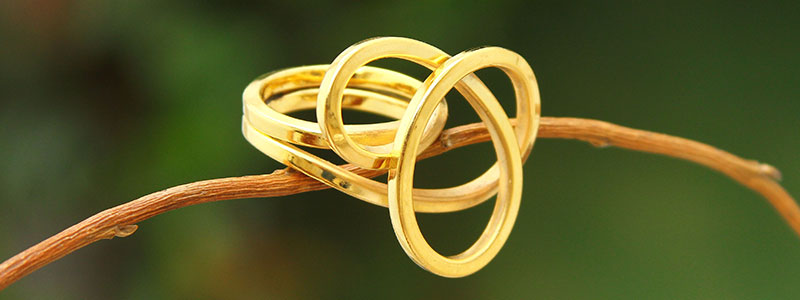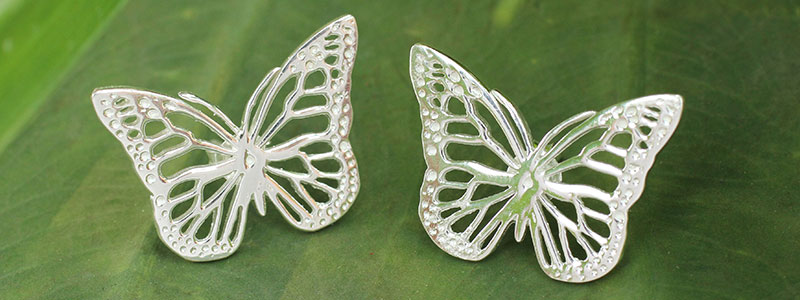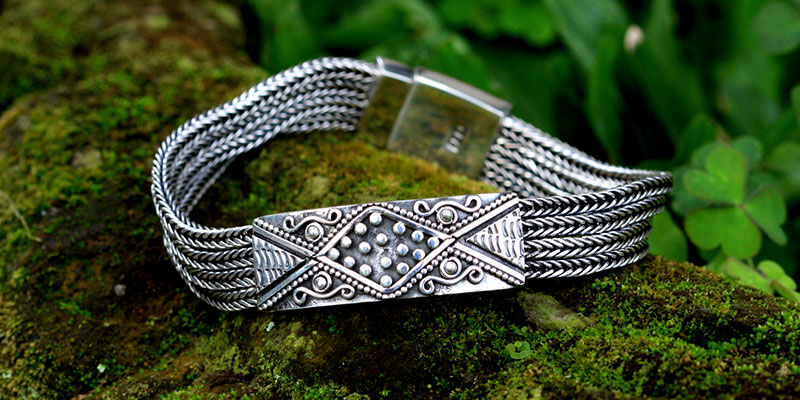Buying jewelry could probably top the list of “Most Fun Activities Ever,” especially if you’re shopping for yourself. But it can also be downright confusing if you don’t know a few basics about jewelry materials — particularly about precious metals, which are hard to ignore if you’re looking for the perfect bracelet, necklace, earrings, or ring.
Since precious metals in contemporary jewelry play such an important role in the appearance, durability, and cost of any piece, it’s a good idea to familiarize yourself with a few basic metallurgy terms. With this foundation in the materials of jewelry, you’ll leave ready to make informed decisions when buying precious metal jewelry and choose a piece that’s just right for you.
What makes precious metals “precious”?
Precious metals are simply very rare metals that also have desirable characteristics — like their ability to make beautiful jewelry. Only eight metals are deemed precious: silver, gold, and the six metals of the platinum family (platinum, palladium, rhodium, ruthenium, iridium, and osmium).
Precious metals used to make jewelry are also “noble” metals. Unlike easily-oxidized base metals like nickel, brass, and copper, noble metals have a high surface luster and do not rust or corrode, which means they can last for many, many years. (Recall the gold burial mask of Egypt’s King Tutankhamun, which shines as brightly today as it did in ancient times!)
Gold

Gold has been one of the most sought-after materials — in jewelry-making and otherwise — since long before the beginning of recorded history. It’s easy to see why: it doesn’t tarnish easily or corrode, and its luster and color are quite attractive. Jewelry artisans can incorporate gold into a large range of designs, either by using it for base pieces or by using it alongside other elements, and many distinctive styles and techniques for gold jewelry have emerged over the years.
Gold’s malleability (or “softness”) makes it the easiest metal to work with, but pure gold is too soft for most jewelry and would scratch or bend easily. It’s therefore usually blended with silver or copper for a more resilient alloy. Jewelers use the term karat (abbreviated “k” or “kt”) to describe the percentage of pure gold in the alloy, with 24 karats being pure gold and lower karat ratings proportionally less. (Not to be confused with carat weight, used for measuring precious gems.)
Purities of gold
24 Karat: 99.9% Pure
22 Karat: 91.7% Pure
18 Karat: 75% Pure
14 Karat: 58.3% Pure
12 Karat: 50% Pure
10 Karat: 41.7% Pure
Types of gold jewelry
Goldsmiths can create a wide variety of gold jewelry, with specialized terms to indicate how they make each piece. Different types of gold jewelry are also priced differently, with different frequencies of wear intended. Knowing the different types of gold jewelry can help you distinguish a trendy necklace that you’d wear in a casual setting from an heirloom piece that you want your grandkids to enjoy.

Solid gold — “Solid gold” refers to an alloy that contains at least 10k of gold, and is not hollow.
Gold-plated — Gold-plated items have been coated with gold of at least 10k. A base metal, such as brass, is dipped into a bath of electroplating solution, with a lump of solid gold. When an electric current is applied, a thin layer of gold is deposited on the metal. Since the plating is thin (usually about 7 to 20 micro inches), the plate on can come off with frequent wear.
Gold-filled — “Gold-filled” (also “gold overlay” or “rolled gold-plated”) also refers to items with a coating of 10k or greater gold, but in gold-filled jewelry the gold is mechanically bonded to the base metal in a more durable fashion than with simple gold plate.
Gold vermeil — “Gold vermeil” (pronounced “vermay“) also refers to a coating of gold on the outside of another metal, but entails a much thicker layer (at least 100 micro inches). Gold vermeil is done over sterling silver, and the coating has a purity of at least 14k. Gold vermeil jewelry is much more durable than regular gold-plated jewelry.
White gold — White gold is an alloy of gold and nickel, sometimes also containing palladium or zinc. These metals lend the gold a pale, platinum-like color (whereas copper and silver enhance gold’s natural golden hue).
Blue gold — Blue gold is an alloy of gold and ferrous (iron-containing) metals, resulting in gold with a bluish tinge.
Rose gold — Rose gold is an alloy that combines gold with copper to create a golden metal with a reddish hue.
Silver

No matter how many new materials appear on the market, people will never get tired of silver jewelry. Like gold, silver has been popular for thousands and thousands of years because of its versatility, luster, and rarity. But again like gold, silver is too soft in its pure state for use in jewelry and must be alloyed with other metals (typically copper) to prevent scratching and distortion. The purer the silver, the more easily it is scratched.
Unlike gold, silver is not rated by karats. Instead, jewelers use the terms “fine” and “sterling” to refer to very pure silver, although fine silver is less commonly used for jewelry-making.
Purities of silver
800 silver — Silver containing 80 percent silver and 20 percent copper or other metal.
925 sterling silver — Sterling silver contains at least 92.5 percent silver and no more than 7.6 percent copper or other metal (a universally accepted standard, originally decreed in 1300 by England’s King Edward the First).
950 sterling silver — 950 silver contains at least 95 percent silver and no more than 5 percent copper or other metal.
Fine silver — Fine silver contains 99.9 percent silver that is too soft to be used for most jewelry, but is sometimes applied in a thin coating over sterling silver to make it appear shinier.

Platinum
Rarer and pricier than gold, the six metals in the platinum family are the finest of the precious metals. Platinum is a silver-white metal found worldwide, typically strengthened with other metals, such as iridium, osmium, or nickel, for use in jewelry. Like silver, platinum is not measured in karats, but rather is stamped with a standardized platinum quality mark by its manufacturer, indicating the percentage of platinum contained (Pt1000 denotes pure platinum).
Platinum is the most durable, lustrous, and scratch-resistant of the fine metals, but its scarcity makes it an uncommon material for jewelry-making. (It’s at least 30 times rarer than gold!) Most jewelry artisans prefer gold and silver as raw materials because they can make a greater range and volume of pieces.
Find your perfect piece
Jewelry has been an important part of how we express ourselves for millennia — for those who wear it and for those who make it. So when it comes to selecting your next style, use your knowledge of precious metals to choose with confidence. Whether you’re falling in step with the latest trend or crafting your own style legacy, you’re sure to find a piece that’s perfect for you.
What’s in your jewelry box — do you have a go-to material for your pieces? Tell us about it in the comments!







[…] precious metals used in luxury rings is a major factor in the overall value, appearance and durability of the […]